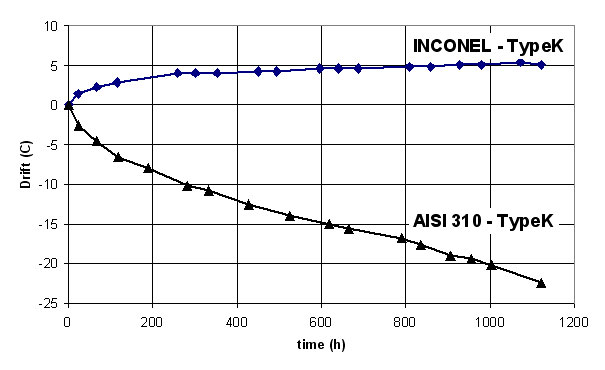|
| THERMOELECTRIC MATERIALS FOR THERMOCOUPLES |
TYPE K THERMOCOUPLE: MIMS CONFIGURATIONThe use of a sheath to protect the thermoelements from the operating environment is a very powerful mean to improve the capability of a thermocouple: it allows to remove the requirements for the thermoelements to withstand the operating environments. Oxidation of the thermoelements, for instance, is not a problem in MIMS thermocouple as long as the sheath provide an effective physical barrier for the oxygen in the atmosphere, so preventing interaction with the thermoelements. However, in a MIMS thermocouple the thermoelements are working in the environement made by the insulator and the sheath: interaction with the insulator and the sheath may affect the stability of the signal and cause drift. Figure18 shows drift for 3mm diameter type K thermocouples sheathed in stainless steel (AISI 310) and Inconel 600 after exposure at 1200°C for about 1000h: the AISI 310 sheathed type K thermocouple shows a more pronounced drift than the Inconel sheathed one. Both the sheaths contain Mn and drift is probably caused by the Mn transfer in vapour phase from the sheath to the thermoelements: the effect is more pronounced for the AISI 310 sheathed thermocouple because the Mn content in AISI 310 is 2at%, while in Inconel is lower than 1at%.
References [1] R.L. Anderson, J.D.Lyons, T.G. Kollie, W.H. Christie, R.Eby, "Decalibration of sheathed |
|||||
|
| Last update: August 31st 2009 © Michele Scervini 2009 |
